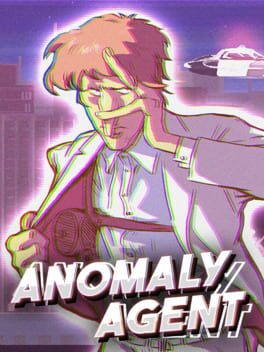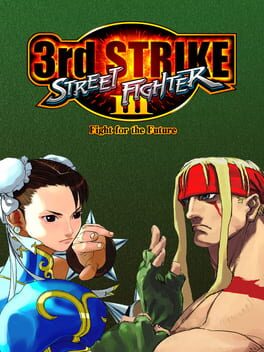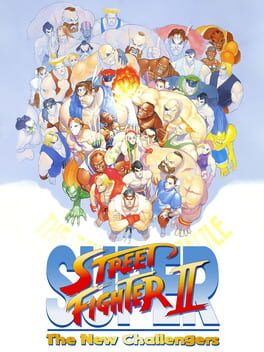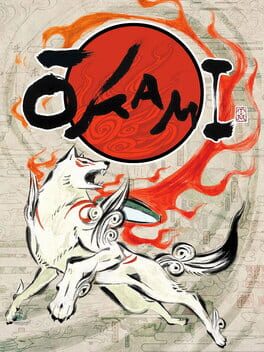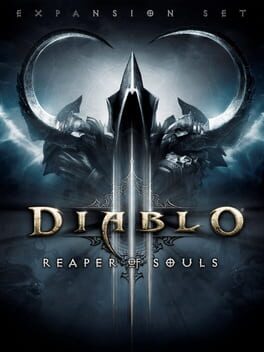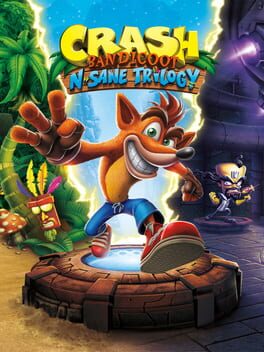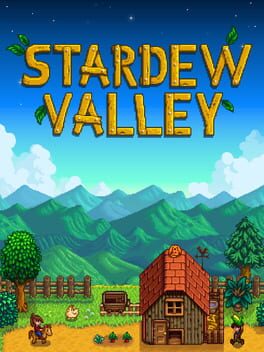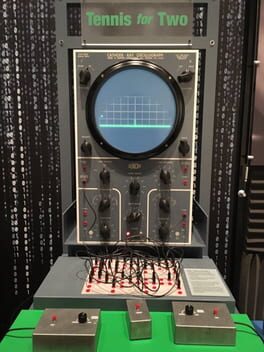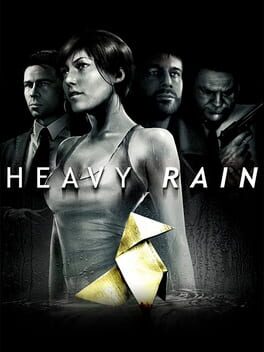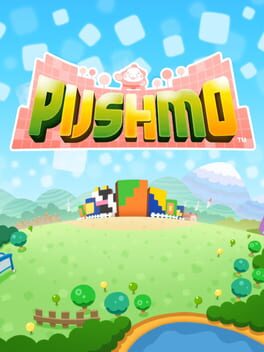thanatost
2329 Reviews liked by thanatost
Anomaly Agent
2024
Halo: Combat Evolved
2001
Firefights in shooters are usually defined by positioning more than anything. Where your Zombiemen and Imps are pretty much defines how the whole thing is gonna go down, and just pulling out the right weapon for the job is pretty much the big decision the player makes when engaging. Halo is different. Positioning matters, but it's not always due to the designers hand that the player and enemies end up in their positions - it's the aliens themselves choosing where they go. Reloading a save for the same encounter will still often see it going drastically differently each time, and this is due to a multitude of factors: Master Chief has a limited arsenal at all times, and the enemies you fight directly tie into this. You will actually need to consider which weapon you want to keep as you can't predict which enemies will be ahead of you, or what they'll be equipped with, or where they'll be. Master Chief also has a shield system that will work alongside your healthbar, with which you get a brief window of protection from oncoming strikes but not full-blown protection; giving you just enough time to perform any risky maneuvers you may need. Everything you do is slightly delayed; from jumps to grenade throws and explosions to reloads delaying your fire to punches landing, giving you a constant need to think about every action you take. The real icing on the cake here though is the intelligence of the Covenant enemies, and how they interact with everything else.
The Covenant has, by no stretch of the imagination, probably the best artificial intelligence ever seen in the genre. The designers have claimed they merely attempted to make them seem smart rather than be smart since they weren't sure how to do that, but I'd argue they hit two birds with one stone. The real trick is that they're reactive, and equal. Reactive in the sense of emotionally expressing reactions to almost every situation, but reactive also in the sense of seemingly playing alongside the player for each gunfight. They'll flank you, toss grenades whenever you get into a comfy position too long or just overwhelm you with numbers. For almost every strategy you have, the Covenant have something up their sleeves to counter it usually. Each Elite has a shield system of their own, so every single fight you get into with an Elite will likely lead in you both taking cover to regenerate since Halo knows to also give the foes some self-preservation instinct. Want to charge in and just damage the Elite? They'll probably do the same; get pissed off and charge at you just hoping to kill you before you put them down. Hell, you might try sniping an Elite only for him to hop in a Banshee and start circling you in the air, and the thing is; this is only the Elites, and while yes: they are the most intelligent Covenant enemies, the true magic is emergence. This is only describing one Elite, what about two? What about his squad of Grunts? Well if you leave the Elite alive they'll have the confidence to charge in and try attacking you on their own terms, but if you take out the Elite first you'll be opening yourself up to them and the Jackals fire. Your assault rifle will make short work of the Grunts, but can it counter the Jackals and Elites shields? That's something new to consider, so you'll want to keep multiple types of weapons on you at once for this situation. What if there's too many to take out? Well there might be a Warthog nearby which you could straight up crash into them with, or just have a Marine fire for you as you strafe around them. Every single encounter requires you to rethink and preplan how you'll handle things, and you'll always need to keep on top of ammo/charge per weapon too; so you can't rely on, well, old reliable, forever.
Just when you've gotten comfy, the game throws the Flood at you. As divisive as they are, and as arguable the Library's quality is, I'd wager they're a necessity. They're a great shake-up to the more strategic combat centered around the Covenant, requiring you to pretty much treat every encounter with them as a gauntlet as they eat up bullets and plasma but just don't go down, and will revive other enemies as more of themselves. But just as is the case with the Covenant, emergence is their true strength. Late-game Halo: Combat Evolved has you overseeing armies of Flood and Covenant fighting to the death and it's your job to just get by while the games systems play their own little RTS as you go off shotgunning more zombies.
The truth to Halo's design is it's multifacted, and it makes the most out of very little. Compared to your average shooter there's not much variety in the enemies or weapons but the core behaviors are so nuanced and dynamic that they change moment-to-moment, encounter-to-encounter. It gives you a sandbox of weapons and vehicles against decently tough enemies (though this will vary depending on the difficulty you pick, but I recommend Heroic as it seems to be the intended experience) and asks how you will deal with it. Halo gives you tons of ways to play, but the enemies can play at that game too and utilize basically anything you can. It leads to an immense creativity in encounters that comes from the most fun form of problem-solving that makes it, in my eyes, one of the crowning jewels of the genre. None of the sequels rivaled the quality of the combat, because it's already the pinnacle of evolution.
The Covenant has, by no stretch of the imagination, probably the best artificial intelligence ever seen in the genre. The designers have claimed they merely attempted to make them seem smart rather than be smart since they weren't sure how to do that, but I'd argue they hit two birds with one stone. The real trick is that they're reactive, and equal. Reactive in the sense of emotionally expressing reactions to almost every situation, but reactive also in the sense of seemingly playing alongside the player for each gunfight. They'll flank you, toss grenades whenever you get into a comfy position too long or just overwhelm you with numbers. For almost every strategy you have, the Covenant have something up their sleeves to counter it usually. Each Elite has a shield system of their own, so every single fight you get into with an Elite will likely lead in you both taking cover to regenerate since Halo knows to also give the foes some self-preservation instinct. Want to charge in and just damage the Elite? They'll probably do the same; get pissed off and charge at you just hoping to kill you before you put them down. Hell, you might try sniping an Elite only for him to hop in a Banshee and start circling you in the air, and the thing is; this is only the Elites, and while yes: they are the most intelligent Covenant enemies, the true magic is emergence. This is only describing one Elite, what about two? What about his squad of Grunts? Well if you leave the Elite alive they'll have the confidence to charge in and try attacking you on their own terms, but if you take out the Elite first you'll be opening yourself up to them and the Jackals fire. Your assault rifle will make short work of the Grunts, but can it counter the Jackals and Elites shields? That's something new to consider, so you'll want to keep multiple types of weapons on you at once for this situation. What if there's too many to take out? Well there might be a Warthog nearby which you could straight up crash into them with, or just have a Marine fire for you as you strafe around them. Every single encounter requires you to rethink and preplan how you'll handle things, and you'll always need to keep on top of ammo/charge per weapon too; so you can't rely on, well, old reliable, forever.
Just when you've gotten comfy, the game throws the Flood at you. As divisive as they are, and as arguable the Library's quality is, I'd wager they're a necessity. They're a great shake-up to the more strategic combat centered around the Covenant, requiring you to pretty much treat every encounter with them as a gauntlet as they eat up bullets and plasma but just don't go down, and will revive other enemies as more of themselves. But just as is the case with the Covenant, emergence is their true strength. Late-game Halo: Combat Evolved has you overseeing armies of Flood and Covenant fighting to the death and it's your job to just get by while the games systems play their own little RTS as you go off shotgunning more zombies.
The truth to Halo's design is it's multifacted, and it makes the most out of very little. Compared to your average shooter there's not much variety in the enemies or weapons but the core behaviors are so nuanced and dynamic that they change moment-to-moment, encounter-to-encounter. It gives you a sandbox of weapons and vehicles against decently tough enemies (though this will vary depending on the difficulty you pick, but I recommend Heroic as it seems to be the intended experience) and asks how you will deal with it. Halo gives you tons of ways to play, but the enemies can play at that game too and utilize basically anything you can. It leads to an immense creativity in encounters that comes from the most fun form of problem-solving that makes it, in my eyes, one of the crowning jewels of the genre. None of the sequels rivaled the quality of the combat, because it's already the pinnacle of evolution.
Hypnospace Outlaw
2019
We're all blessed/cursed to live in the age where the Internet is ubiquitous. In it we pour pieces of ourselves, in a gigantic web of communications, friendships, relationships, rivalries, petty grievances and every human interaction. Hypnospace Outlaw is like a mirror held up to us, in which we see a microcosm of our Internet selves, frozen in time in the moment we left our digital footprints. It's a story where you visit a fictional past, one unabashedly based on our actual history, whose concerns are still distressingly relevant twenty years later. Alexandria still burns, our past is still lost each passing hour. One day, this site will be no more, Steam will be no more, we will likely be no more, no matter how remote that day may be or seem. This doesn't mean being here is meaningless; even if it were, what's the point in having all the miracolous opportunities we're afforded and not using them?
Enjoy today, now. And if something breaks? There's a saying where I come from: "Pope's dead, make another".
Keep on rocking, reader. Godspeed.
Enjoy today, now. And if something breaks? There's a saying where I come from: "Pope's dead, make another".
Keep on rocking, reader. Godspeed.
Ōkami
2006
bland and paper-thin in almost every regard, stretched out to an absurd length making for an overall miserable experience in my opinion
from the very first moments of the game you're assaulted with walls and walls of just the most boring, repetitious dialogue, and it's always either banal exposition about the ancient evil corrupting the land, or a prophecy or other played out fluff like that, overbearing tutorialisng about stuff like don't like walk into fire or something, or incredibly tepid attempts at humour that almost never landed for me, your companion character issun's constant harassment towards like every woman you come across was particularly painful
i found none of the characters interesting or likeable, aside from amaterasu because she's really cute
it doesn't help that almost all of these long conversations are presented in the most boring 'A cam to B cam' kind of way, near the end of the game i realised i was reading the words, but i was retaining nothing, i found it tragically funny when near the end when all the characters you've met along the way were praying for me and giving me words of encouragement and all that, i didn't know who half of them were
the game has dungeons akin to ones you'd find in zelda games, but if you're hoping for some good puzzles like i was you'll be very disappointed, they're usually just a long series of rooms with puzzles i figured out in like a second without effort, turning them into a slog
this is partially due to the brush techniques, the main gimmick of the game. these allow you to manipulate the environment around you, but they're all pretty uninspired; draw a line from some fire and you can melt some ice, use some wind to make a thingy turn, use some ice to freeze something in place, slow down time so you can run past a fast guy, make specific parts of water go up, etc.
these are not only boring and kinda clunky to use but the way they're set up is part of what makes the puzzles so obvious, if a room has fire in it, you're probably going to use it, if you see a swirly bit of water, you're probably going to use it, and it rarely gets more complicated than that, you rarely have to like combine them together in an interesting way or anything like that, and you can't really give a 'wrong answer' to any of the puzzles if that makes sense, it's just drag this one thingy to this other thingy and a door opens more often than not
the slowing down time ability is also funny because once you get it, 99% of the combat encounters become just spamming it and mashing X, meaning most of the brush techniques are on par with bad zelda items; being glorified keys rather than tools for general use
if these were the only issues i would find okami to be merely mediocre, but it's so ridiculously long for how shallow it is that it crosses a line
the game is essentially JUST this, along with running back and forth across an oversized overworld, for over thirty hours, and i wanted it to be over after two
it never gets any better, i had to take breaks from it for days at a time and considered dropping it at multiple points, it was heartbreaking whenever i thought i'd killed the final boss and then like a dark cloud comes out of it and it goes somewhere else and the narrator lady is like 'wow their journey is FAR from over!!'
this happened multiple times, and it got even worse when the game started needlessly recycling content as well, making you re-fight a load of bosses you've already fought
i was kind of indifferent to the artstyle in all honesty, but that underwater area looked amazing. i felt similarly about the music, i mostly found it kinda dull but there were a handful of songs i really liked and enhanced some moments i otherwise wouldn't have cared about. i also liked feeding all the animals as well because they're cute and i like them :3
unfortunately that's the nicest i have to say, okami is just one of the most painfully boring games i've played in quite a while and the only thing i feel after finishing it is a sense of relief. i've literally just finished it, and have already forgotten most of it
from the very first moments of the game you're assaulted with walls and walls of just the most boring, repetitious dialogue, and it's always either banal exposition about the ancient evil corrupting the land, or a prophecy or other played out fluff like that, overbearing tutorialisng about stuff like don't like walk into fire or something, or incredibly tepid attempts at humour that almost never landed for me, your companion character issun's constant harassment towards like every woman you come across was particularly painful
i found none of the characters interesting or likeable, aside from amaterasu because she's really cute
it doesn't help that almost all of these long conversations are presented in the most boring 'A cam to B cam' kind of way, near the end of the game i realised i was reading the words, but i was retaining nothing, i found it tragically funny when near the end when all the characters you've met along the way were praying for me and giving me words of encouragement and all that, i didn't know who half of them were
the game has dungeons akin to ones you'd find in zelda games, but if you're hoping for some good puzzles like i was you'll be very disappointed, they're usually just a long series of rooms with puzzles i figured out in like a second without effort, turning them into a slog
this is partially due to the brush techniques, the main gimmick of the game. these allow you to manipulate the environment around you, but they're all pretty uninspired; draw a line from some fire and you can melt some ice, use some wind to make a thingy turn, use some ice to freeze something in place, slow down time so you can run past a fast guy, make specific parts of water go up, etc.
these are not only boring and kinda clunky to use but the way they're set up is part of what makes the puzzles so obvious, if a room has fire in it, you're probably going to use it, if you see a swirly bit of water, you're probably going to use it, and it rarely gets more complicated than that, you rarely have to like combine them together in an interesting way or anything like that, and you can't really give a 'wrong answer' to any of the puzzles if that makes sense, it's just drag this one thingy to this other thingy and a door opens more often than not
the slowing down time ability is also funny because once you get it, 99% of the combat encounters become just spamming it and mashing X, meaning most of the brush techniques are on par with bad zelda items; being glorified keys rather than tools for general use
if these were the only issues i would find okami to be merely mediocre, but it's so ridiculously long for how shallow it is that it crosses a line
the game is essentially JUST this, along with running back and forth across an oversized overworld, for over thirty hours, and i wanted it to be over after two
it never gets any better, i had to take breaks from it for days at a time and considered dropping it at multiple points, it was heartbreaking whenever i thought i'd killed the final boss and then like a dark cloud comes out of it and it goes somewhere else and the narrator lady is like 'wow their journey is FAR from over!!'
this happened multiple times, and it got even worse when the game started needlessly recycling content as well, making you re-fight a load of bosses you've already fought
i was kind of indifferent to the artstyle in all honesty, but that underwater area looked amazing. i felt similarly about the music, i mostly found it kinda dull but there were a handful of songs i really liked and enhanced some moments i otherwise wouldn't have cared about. i also liked feeding all the animals as well because they're cute and i like them :3
unfortunately that's the nicest i have to say, okami is just one of the most painfully boring games i've played in quite a while and the only thing i feel after finishing it is a sense of relief. i've literally just finished it, and have already forgotten most of it
Resident Evil 4
2005
I am not so ignorant as to sweep Blizzard's malpractices under the rug for the sake of my own enjoyment. Even ignoring the well-known laundry list of human-facing controversies in recent years, their products have dwindled in appeal to me for over a decade. As lamented in my retrospective on Wrath of the Lich King, much of the core identity of World of Warcraft has languished as it is torn apart at the seams by its players, and haphazardly sewn back together with every expansion. My favourite part of Overwatch was quickly dismantled in favour of supposed balance, a Sisyphean treadmill. Hearthstone crumbles under the weight of its power creep and enormity of knowledge required. Heroes of the Storm was left to wither on the vine. And Diablo III dropped from the heavens with a wet thud. So imagine my shock when Reaper of Souls rose from its ashes like a phoenix that hasn't gone out for over nine years now.
My love of World of Warcraft in particular was two-faced until the release of Shadowlands, the nail in the coffin for any fondness I still had for Azeroth. After completing the core expansion, I deleted Battle.net and never again felt the urge to revisit my account.
But Diablo III continued to call to me. And in a moment of weakness, finally bursting through my mental dam with the early access period for Diablo IV I caved, and felt and feel horrible for it. My scruples, irrelevant! Nothing has ever come close to the specific gameplay of Diablo III, and Diablo IV's beta suggests nothing ever will, not even Blizzard's own offerings.
What I adore about Diablo III is exactly what, arguably, makes it a bad ARPG. The combat is largely meaningless. Everything is item driven rather than character dependent. Builds are largely prescribed and difficult to tweak. There is next to no consequence outside of playing on Hardcore (which I have always exclusively done). Adventure Mode and its bounties are so linear it might as well occur in a hallway. Enemies might as well all be the same. Bosses have no interesting mechanics in end-game scenarios. Legendaries inundate the player to the point where you stop even picking them up. The grinding for Primal Ancients is absurd.
I love it all!
Diablo III is a constant that has been with me for over a decade, through good and bad. I have always known I could return to it for a few days or a week, click things, have them explode, and revel in its own chaos. My characters' deaths rarely bother me, if anything they instill in me a drive to do it all over again. Take bigger risks with my build to get back to speed. Try new gear sets with radically different modes of play (even if the end result is always one-shotting everything even on Torment XVI). In an era of games which try for balance above all else, Diablo III has leaned entirely into the fact that a game of its sort is unable to be balanced. Each Season amps up the absurdity of some small factor, showering the player in loot or damage numbers or some other quirk that widens my eyes. And this latest go around, Season 28, has taken this to what must be a maximal realisation. The new altar destroys any remaining shreds of balance and gets the player as close as possible to basically using a trainer.
I adore it, and I truly missed it. My time with the season is probably at an end, but I will likely return. If not for the next one, then some other season down the line. I'll shake my head the whole time then, just as I did now, so everyone knows I disagree.
My love of World of Warcraft in particular was two-faced until the release of Shadowlands, the nail in the coffin for any fondness I still had for Azeroth. After completing the core expansion, I deleted Battle.net and never again felt the urge to revisit my account.
But Diablo III continued to call to me. And in a moment of weakness, finally bursting through my mental dam with the early access period for Diablo IV I caved, and felt and feel horrible for it. My scruples, irrelevant! Nothing has ever come close to the specific gameplay of Diablo III, and Diablo IV's beta suggests nothing ever will, not even Blizzard's own offerings.
What I adore about Diablo III is exactly what, arguably, makes it a bad ARPG. The combat is largely meaningless. Everything is item driven rather than character dependent. Builds are largely prescribed and difficult to tweak. There is next to no consequence outside of playing on Hardcore (which I have always exclusively done). Adventure Mode and its bounties are so linear it might as well occur in a hallway. Enemies might as well all be the same. Bosses have no interesting mechanics in end-game scenarios. Legendaries inundate the player to the point where you stop even picking them up. The grinding for Primal Ancients is absurd.
I love it all!
Diablo III is a constant that has been with me for over a decade, through good and bad. I have always known I could return to it for a few days or a week, click things, have them explode, and revel in its own chaos. My characters' deaths rarely bother me, if anything they instill in me a drive to do it all over again. Take bigger risks with my build to get back to speed. Try new gear sets with radically different modes of play (even if the end result is always one-shotting everything even on Torment XVI). In an era of games which try for balance above all else, Diablo III has leaned entirely into the fact that a game of its sort is unable to be balanced. Each Season amps up the absurdity of some small factor, showering the player in loot or damage numbers or some other quirk that widens my eyes. And this latest go around, Season 28, has taken this to what must be a maximal realisation. The new altar destroys any remaining shreds of balance and gets the player as close as possible to basically using a trainer.
I adore it, and I truly missed it. My time with the season is probably at an end, but I will likely return. If not for the next one, then some other season down the line. I'll shake my head the whole time then, just as I did now, so everyone knows I disagree.
That awful song was right, it should have been a genius, but it doesn't quite compute.
All in all, a collection that brings back old classics with a beautiful new look and even some brand new content... and also that seems to still retain the problems of the games and, worst of all, introduces new ones, with hitboxes and collisions that... could have been better.
Not gonna over extended myself since I reviewed all the games individually (You can see my reviews throught the links below) but yeah, while its fucntional, it could have been way, way better, but at least I got the chance to experience these classics with a neat visual style.
My review of Crash Bandicoot
My review of Crash Bandicoot 2: Cortex Strikes Back
My review of Crash Bandicoot: Warped
All in all, a collection that brings back old classics with a beautiful new look and even some brand new content... and also that seems to still retain the problems of the games and, worst of all, introduces new ones, with hitboxes and collisions that... could have been better.
Not gonna over extended myself since I reviewed all the games individually (You can see my reviews throught the links below) but yeah, while its fucntional, it could have been way, way better, but at least I got the chance to experience these classics with a neat visual style.
My review of Crash Bandicoot
My review of Crash Bandicoot 2: Cortex Strikes Back
My review of Crash Bandicoot: Warped
Stardew Valley
2016
It’s personal
At the beginning of 2020 when everyone with a Switch was playing the new Animal Crossing I inherited my grandfather’s farm in a quaint town of Stardew Valley, have you heard of it?
I found a new life there that was everything I wanted & exactly what I needed at a time where I felt like it was my fucking duty to wait for the news broadcasts to tell me more bad news & scroll infinitely on Twitter to find more people in my same frame of mind as I was where we were all terrified & had to work in positions where business owners didn’t want to protect us & nobody cared that we were scared or that our families couldn’t stand to get sick
I came back in 2022 after losing both of my grandmas in less than a year & my grandpa needed to be placed in long term care because my family couldn’t properly care for him anymore
Recently my dad has been in poor health, avoiding hospitalization and struggling with a lot of anxiety and paranoia made increasingly worse by medicines that have been prescribed to maybe hopefully help eventually I think. We’re all scared and I’ve found myself thinking of a trip to Stardew to be with my cows and my chubby piggies and chickens and back to growing pumpkins and kicking blueberries around my greenhouse and saying hi to my little bats in the cave right behind it…
The more I want to visit my farm, the more I wish my dad could go too
A place where you can let go of your anxieties
A home away from home, but not too far
At the beginning of 2020 when everyone with a Switch was playing the new Animal Crossing I inherited my grandfather’s farm in a quaint town of Stardew Valley, have you heard of it?
I found a new life there that was everything I wanted & exactly what I needed at a time where I felt like it was my fucking duty to wait for the news broadcasts to tell me more bad news & scroll infinitely on Twitter to find more people in my same frame of mind as I was where we were all terrified & had to work in positions where business owners didn’t want to protect us & nobody cared that we were scared or that our families couldn’t stand to get sick
I came back in 2022 after losing both of my grandmas in less than a year & my grandpa needed to be placed in long term care because my family couldn’t properly care for him anymore
Recently my dad has been in poor health, avoiding hospitalization and struggling with a lot of anxiety and paranoia made increasingly worse by medicines that have been prescribed to maybe hopefully help eventually I think. We’re all scared and I’ve found myself thinking of a trip to Stardew to be with my cows and my chubby piggies and chickens and back to growing pumpkins and kicking blueberries around my greenhouse and saying hi to my little bats in the cave right behind it…
The more I want to visit my farm, the more I wish my dad could go too
A place where you can let go of your anxieties
A home away from home, but not too far
Tennis for Two
1958
Iron Lung
2022
I can confidently say, as the eminent expert on the subject matter, that Iron Lung (2022) is the worst game with Lung in the title. I'd usually have something semi-witty or insightful to say but all I'm feeling right now is saying that Iron Lung is poopoo peepee do-do and sucks. The only positive I can think of is that wild polio has been eradicated in all continents except for Asia.
Heavy Rain
2010
Quite possibly (and quite likely to be) one of the funniest video games ever released. David Cage is like the Ed Wood of the video game industry, but only if Ed Wood had zero charm, a legacy that’s seen as a joke rather than an inspiration, and a fandom of incredibly strange sycophants who have tricked themselves into thinking any of his stories would be able to hack it on daytime television.
Heavy Rain is an experience, and one that you legitimately owe it to yourself to play. This isn’t because it’s good, but rather because it’s atrocious. Games critics were over the moon for this back in 2010. People were desperate to totally own Roger Ebert for saying video games couldn’t be art, so they latched onto shit like this. It’s a poorly-acted, poorly-scripted, poorly-thought out mess. It's like a living guide on how not to make a game. It’s incredible. Get some friends together and make a stream night or two out of it.
Ethan Mars can have both of his children murdered and then be propositioned for sex by his new love interest while kneeling atop their graves. He then walks to his car and kills himself. This is supposed to be sad and not actually the most hilarious thing you’ve ever seen in your entire life.
Heavy Rain is an experience, and one that you legitimately owe it to yourself to play. This isn’t because it’s good, but rather because it’s atrocious. Games critics were over the moon for this back in 2010. People were desperate to totally own Roger Ebert for saying video games couldn’t be art, so they latched onto shit like this. It’s a poorly-acted, poorly-scripted, poorly-thought out mess. It's like a living guide on how not to make a game. It’s incredible. Get some friends together and make a stream night or two out of it.
Ethan Mars can have both of his children murdered and then be propositioned for sex by his new love interest while kneeling atop their graves. He then walks to his car and kills himself. This is supposed to be sad and not actually the most hilarious thing you’ve ever seen in your entire life.
‘Grass isn’t against the law!’
– Ricardo Cortés, It's just a plant, 2005.
Played during the Backloggd’s Game of the Week (Mar. 28 – Apr. 3, 2023).
The 1990s saw a shift in the Christian Right's rhetoric towards LGBT communities. In previous decades, most arguments focused on the alleged pathological deviance of these groups, associating homosexuality with paedophilia and mental illness. At the same time, this rhetorical framework made it possible to assert the superiority of Christian values, threatened by a new Sodom and Gomorrah. A clear illustration of the ideological shift can be seen in the vote on Amendment 2 to the Colorado Constitution (1992) and its subsequent ruling of unconstitutionality by the Supreme Court (Romer v. Evans, 1996). The text sought to prohibit any law or decision protecting minorities in the State on the grounds of sexual orientation: it was passed by popular initiative before being struck down by both the Colorado Supreme Court and the Federal Court. The dissenting opinions in these rulings stressed that Amendment 2 should not be an issue, as it did not seek to deny rights to homosexuals, but only to prevent any form of affirmative action.
The American conservative right's new means of action
This ideological stance reflects a malaise that has plagued America since the Reagan presidency: since the civil rights movements, decisions to protect vulnerable groups have been seen as preferential treatment that disadvantages white middle-class Americans – the electoral backbone of conservatives. The Amendment 2 campaign was largely led by Colorado for Family Values, co-founded by Tony Marco. An ex-gay, Marco has largely steered the campaign away from traditional arguments in favour of a legalistic and misleading sociological approach. He repeatedly states that "gays are no 'minority'; gay militants constitute a rich, powerful special interest. And, to coin a phrase, enough money makes anyone a 'majority’" [1]. Didi Herman explains that this line of argument has been adopted by conservative movements that have sought to regain respectability by avoiding overtly religious discourse; certainly the Christian Right was largely convinced of the immorality and sinfulness of homosexuals, but publicly it had to be reasonable and fight on a more liberal ground, that of rights and law. [2]
This less explicitly extremist discourse finds institutional expression in the 'war on drugs', initiated by the creation of the Drug Enforcement Administration in 1973. Since the Reagan presidency, and especially during the Bush administration, the budget for these actions has increased from $5 million to over $600 million. [3] This 'war on drugs' has been characterised by, among other things, the militarisation of borders, political interference in South American countries, and an increase in abusive arrests, particularly of racial minorities. Most of the literature on the social consequences of the 'war on drugs' focuses, for understandable reasons, on its impact on ethnic minorities, and much research remains to be done on the links between LGBT communities, the AIDS epidemic and 'war on drugs' policies. However, recent studies show how it is being used as a moral panic to criminalise LGBT people who are more vulnerable and at risk of using these substances. [4]
Very explicit and simplistic LGBT references
It is in this very broad social context that Foobar versus the DEA must be understood. Like other LGBT games of the period – Caper in the Castro (1989), a point-n-click game featuring a lesbian detective, comes to mind – Foobar versus the DEA reuses relatively familiar gameplay elements, in this case the shoot'em up formula inspired by Xevious (1983). From a technical point of view, the game showcases the new capabilities of Mac machines, but remains relatively behind the rest of video game production. The player assumes the role of Foobar, whose outfit is largely inspired by comic book superheroes, on a quest to find his boyfriend Ned, who has been unjustly arrested by the DEA. To free him, Foobar must take on the entire American penal system, backed by capitalist industry, the media and a Big Brother-like super-computer.
The title is divided into four levels, each featuring one of the stakeholders in this 'war on drugs'. The game does not conceal its LGBT references or its disdain for authority, as the various power-ups make no attempt at subtlety: the rainbow flag adds one life to the counter, and the American flag-draped condom – which actually looks a lot like a missile – serves as a shield. The pointer that marks the drop point of the bombs is, incidentally, a pink triangle, the symbol of the gay community. There is a playful irreverence in these elements, but the militaristic aspect of the title seems a little odd. Not that there should be no violence against state institutions and their repressive policies, but Foobar versus the DEA features mostly traditional military weapons in what is technically an air raid. This can be seen as an ironic reversal of American practices, but there is a lack of purposefulness in the process, to the point where one might suspect an internalisation of American methods.
Archaic in its design, modern in its representation
For the rest, Foobar versus the DEA is a mediocre title. The airship's manoeuvrability is rather poor, which makes dodging projectiles frustrating, especially as the hitboxes seem very permissive. The missiles, which fly horizontally across the screen, are probably the worst feature, as they force the player to stay in the middle of the screen, reducing the space available for manoeuvring. The game is generally devoid of any real gameplay ambitions, as it is so much a rehash of the conventions of the time, which were already archaic in 1996. The lack of variety in the enemies and their erratic movements make every death particularly tedious, as does the very slow scrolling, which adds to the impression of interminable levels. Admittedly queer-coded for its time, the game does not manage to instil its themes beyond a few visual elements and synopsis statements.
This is a shame, because Foobar versus the DEA, shared as a freeware, represents the versatility of the LGBT community in the midst of the great social, economic and health crisis it experienced in the United States during the 1980s and 1990s. The game confronts the mainstream representations that still nourished that era; similar to the New Queer Cinema, led by a new generation of filmmakers and characterised by a very offensive rhetoric against the patriarchal and religious order, Foobar versus the DEA does not hesitate to attack industry giants, media and state institutions. Although it struggles to be a convincing experiment from a purely technical standpoint, it is an important record in the cultural history of the LGBT community.
__________
[1] Tony Marco, Shaky Foundation: Twelve 'Big Lies' The 'Gay Rights' Movement is Built on, 1993, quoted in Didi Herman, '(Il)legitimate Minorities: The American Christian Right's Anti-Gay-Rights Discourse', in Journal of Law and Society, vol. 23, no. 3, p. 350.
[2] Didi Herman, op. cit.
[3] Yulia Vorobyeva, ‘Illegal Drugs as a National Security Threat: Securitization of Drugs in the U.S. Official Discourse’, in Bruce M. Bagley, Jonathan D. Rosen (ed.), Trafficking, Organized Crime, and Violence in the Americas Today, University of Florida Press, Gainesville, 2015, p. 50.
[4] Grace Ramsey, ‘How the War on Drugs Harms the LGBTQIA+ Community’, in Drug Policy Alliance, 22nd June 2018, consulted on 30 March 2023.
– Ricardo Cortés, It's just a plant, 2005.
Played during the Backloggd’s Game of the Week (Mar. 28 – Apr. 3, 2023).
The 1990s saw a shift in the Christian Right's rhetoric towards LGBT communities. In previous decades, most arguments focused on the alleged pathological deviance of these groups, associating homosexuality with paedophilia and mental illness. At the same time, this rhetorical framework made it possible to assert the superiority of Christian values, threatened by a new Sodom and Gomorrah. A clear illustration of the ideological shift can be seen in the vote on Amendment 2 to the Colorado Constitution (1992) and its subsequent ruling of unconstitutionality by the Supreme Court (Romer v. Evans, 1996). The text sought to prohibit any law or decision protecting minorities in the State on the grounds of sexual orientation: it was passed by popular initiative before being struck down by both the Colorado Supreme Court and the Federal Court. The dissenting opinions in these rulings stressed that Amendment 2 should not be an issue, as it did not seek to deny rights to homosexuals, but only to prevent any form of affirmative action.
The American conservative right's new means of action
This ideological stance reflects a malaise that has plagued America since the Reagan presidency: since the civil rights movements, decisions to protect vulnerable groups have been seen as preferential treatment that disadvantages white middle-class Americans – the electoral backbone of conservatives. The Amendment 2 campaign was largely led by Colorado for Family Values, co-founded by Tony Marco. An ex-gay, Marco has largely steered the campaign away from traditional arguments in favour of a legalistic and misleading sociological approach. He repeatedly states that "gays are no 'minority'; gay militants constitute a rich, powerful special interest. And, to coin a phrase, enough money makes anyone a 'majority’" [1]. Didi Herman explains that this line of argument has been adopted by conservative movements that have sought to regain respectability by avoiding overtly religious discourse; certainly the Christian Right was largely convinced of the immorality and sinfulness of homosexuals, but publicly it had to be reasonable and fight on a more liberal ground, that of rights and law. [2]
This less explicitly extremist discourse finds institutional expression in the 'war on drugs', initiated by the creation of the Drug Enforcement Administration in 1973. Since the Reagan presidency, and especially during the Bush administration, the budget for these actions has increased from $5 million to over $600 million. [3] This 'war on drugs' has been characterised by, among other things, the militarisation of borders, political interference in South American countries, and an increase in abusive arrests, particularly of racial minorities. Most of the literature on the social consequences of the 'war on drugs' focuses, for understandable reasons, on its impact on ethnic minorities, and much research remains to be done on the links between LGBT communities, the AIDS epidemic and 'war on drugs' policies. However, recent studies show how it is being used as a moral panic to criminalise LGBT people who are more vulnerable and at risk of using these substances. [4]
Very explicit and simplistic LGBT references
It is in this very broad social context that Foobar versus the DEA must be understood. Like other LGBT games of the period – Caper in the Castro (1989), a point-n-click game featuring a lesbian detective, comes to mind – Foobar versus the DEA reuses relatively familiar gameplay elements, in this case the shoot'em up formula inspired by Xevious (1983). From a technical point of view, the game showcases the new capabilities of Mac machines, but remains relatively behind the rest of video game production. The player assumes the role of Foobar, whose outfit is largely inspired by comic book superheroes, on a quest to find his boyfriend Ned, who has been unjustly arrested by the DEA. To free him, Foobar must take on the entire American penal system, backed by capitalist industry, the media and a Big Brother-like super-computer.
The title is divided into four levels, each featuring one of the stakeholders in this 'war on drugs'. The game does not conceal its LGBT references or its disdain for authority, as the various power-ups make no attempt at subtlety: the rainbow flag adds one life to the counter, and the American flag-draped condom – which actually looks a lot like a missile – serves as a shield. The pointer that marks the drop point of the bombs is, incidentally, a pink triangle, the symbol of the gay community. There is a playful irreverence in these elements, but the militaristic aspect of the title seems a little odd. Not that there should be no violence against state institutions and their repressive policies, but Foobar versus the DEA features mostly traditional military weapons in what is technically an air raid. This can be seen as an ironic reversal of American practices, but there is a lack of purposefulness in the process, to the point where one might suspect an internalisation of American methods.
Archaic in its design, modern in its representation
For the rest, Foobar versus the DEA is a mediocre title. The airship's manoeuvrability is rather poor, which makes dodging projectiles frustrating, especially as the hitboxes seem very permissive. The missiles, which fly horizontally across the screen, are probably the worst feature, as they force the player to stay in the middle of the screen, reducing the space available for manoeuvring. The game is generally devoid of any real gameplay ambitions, as it is so much a rehash of the conventions of the time, which were already archaic in 1996. The lack of variety in the enemies and their erratic movements make every death particularly tedious, as does the very slow scrolling, which adds to the impression of interminable levels. Admittedly queer-coded for its time, the game does not manage to instil its themes beyond a few visual elements and synopsis statements.
This is a shame, because Foobar versus the DEA, shared as a freeware, represents the versatility of the LGBT community in the midst of the great social, economic and health crisis it experienced in the United States during the 1980s and 1990s. The game confronts the mainstream representations that still nourished that era; similar to the New Queer Cinema, led by a new generation of filmmakers and characterised by a very offensive rhetoric against the patriarchal and religious order, Foobar versus the DEA does not hesitate to attack industry giants, media and state institutions. Although it struggles to be a convincing experiment from a purely technical standpoint, it is an important record in the cultural history of the LGBT community.
__________
[1] Tony Marco, Shaky Foundation: Twelve 'Big Lies' The 'Gay Rights' Movement is Built on, 1993, quoted in Didi Herman, '(Il)legitimate Minorities: The American Christian Right's Anti-Gay-Rights Discourse', in Journal of Law and Society, vol. 23, no. 3, p. 350.
[2] Didi Herman, op. cit.
[3] Yulia Vorobyeva, ‘Illegal Drugs as a National Security Threat: Securitization of Drugs in the U.S. Official Discourse’, in Bruce M. Bagley, Jonathan D. Rosen (ed.), Trafficking, Organized Crime, and Violence in the Americas Today, University of Florida Press, Gainesville, 2015, p. 50.
[4] Grace Ramsey, ‘How the War on Drugs Harms the LGBTQIA+ Community’, in Drug Policy Alliance, 22nd June 2018, consulted on 30 March 2023.
Pushmo
2011
So, that's it for the 3DS eShop, another graveyard of cherished exclusives and flash-in-the-pan experiments which Nintendo will unceremoniously move on from. Not us who lived through it, of course (and we're still able to redownload our libraries, which means even the corp's data centers are holding on). The Big N counts on its newer audiences never fully realizing what they're deprived of, but that's where retrospectives and critical writings both on Backloggd and elsewhere can do some good. Countless years of platform history, and the less lionized parts of developers' histories, would otherwise get lost in the shuffle of countless new systems and software libraries. Pushmo is a perfect example of something once notable but now more at risk of broad indifference or revisionism than ever, aided by its publisher's aversion to curating its legacy in a post-Iwata world. And that's a damn shame because Intelligent Systems' puzzle-platformer played an important part in buoying the 3DS' launch year, with an addictive game loop and plenty of replayability even now thanks to level editing and QR codes.
Pushmo strikes me as a peek into an alternate timeline where the Fire Emblem franchise simply didn't recover from its downturn. Int-Sys likely saw the writing on the wall, given all their staff interviews expressing a real fear of, and resignation to, Awakening being the last true entry in that series. They needed what Jupiter Corp. has with its endless Picross series, a forever repeatable puzzle concept appealing to just about everyone in just about any context, keeping their paychecks secure despite the seemingly inevitable death of their prestige IP. So we got this, a modest but meaty killer app which the eShop sorely needed in lieu of upcoming blockbusters. All seemed going to plan, with critical acclaim and constant word of mouth giving Crashmo and Pushmo World on Wii U the greenlight. But then a funny thing happened: that 3DS Fire Emblem game Int-Sys doubted could resurrect that series? It outperformed the previous FE releases combined, setting a new mandate for the company. The Puzzlemo segue suddenly looked a lot more out of place (alarmist, even) than anticipated.
So today we have seemingly no end of Fire Emblem, Paper Mario, and WarioWare goodness from this long-time Nintendo partner, but nothing like their mid-2010s experiments with these cute block-em-ups, let alone anything as out there as Code Name S.T.E.A.M.. It sucks because, unless you're willing to sail the high seas, this part of Int-Sys' back catalog might as well not exist. What precisely does a spate of throwback logic and jumping exercises, set to orchestral chiptunes and a family-friendly exterior, offer to anyone better acquainted with Three Houses or The Origami King? I'd argue that Pushmo represents the developer's talents in their most pure form, though. It's that very lack of frills, thrills, bombast, and grandiosity which this small series proved it could do without, squaring up to the tentpole stuff with such ease and elegance. One might argue there's not much new here beyond the 3D gimmick, but I digress.
The player's goals of rescuing little sumo wrestlers from sabotaged contraptions in a park is simple enough for Int-Sys to launch players through tutorials before they get bored. Yet it's still flexible by the time this game reaches its proper tier of challenge—those later rounds where one must carefully view the puzzle, backtrack from mistakes, and think multiple steps ahead of danger. I definitely wish all of these Puzzlemo installments offered experienced users the ability to skip earlier worlds via some kind of test/exam mode, just to save me some time on replays, but I don't mind the early stages. They stimulate my small pathetic monkey brain every time I hear that wonderful "clear!" jingle, after all. My main issue with Pushmo comes from the lack of added mechanics towards the end, which lets repetition and a feeling of sameness creep in. Solving pixel art murals is fun much like in Jupiter's nonogram paradigm, but not quite enough.
Even with its limited scope and novelty, I find it super rewarding to revisit Pushmo on Citra today. Quite a few WarioWare staffers led development on this and the rest of the series, hence its ease in activating that "one more turn!" sensation. Each world's paced and sequenced appropriately, feeling like a gentle upward climb vs. the difficulty cliffside that Crashmo provides. This linear mastery of pushing and pulling, navigating tight jumps, cutting off your escape to proceed higher…it all adds up once you reach the bonus worlds, full of homage to Nintendo icons and classic puzzling. Another important piece of the progression is unlocking new options in the level editor, a very relevant feature given how well the game teaches you to recognize and reproduce smart designs. I never got the full experience of building puzzles and sharing them with friends via QRs, sadly, but I can't imagine the lack of said feature here and in the sequels. That same joy that kids made and shared with Lode Runner and Excitebike in the '80s lives on in forms like this, all true to that Family Computer and Game Boy ethos of uncomplicated play.
Much of the game's appeal to me now comes from the aesthetic it promotes. Now, I'm typically not a fella with a penchant for twee or adulterated audiovisuals in my media diet. Anything that feels desperately cuddly, or unwilling to settle on a distinct audience, just seems cowardly to me most of the time. Pushmo avoids this by pairing its Saturday-morning-edutainment look with unassuming but involving brain-teasers, the kind that even adults can sink effort into. This visual style accomplishes a couple things: (a) keeping all elements distinct and readable even when complex, and (b) making me feel like a dumb lil' kindergartner again when I eventually mess up. Some other Nintendo releases from this period went too far in acting cute and patronizing to players—think Skyward Sword or Freakyforms—which is why I think Int-Sys' success here is commendable. Shout-outs to those lovely melodies, too! They're an effortless mind-meld of Famicom-era bleepity bloops and lush orchestration that complement each other maybe too well.
Questions like "where did Puzzlemo go?" bug me for lack of an easy answer. Maybe it's simply the sequels being either too hard for most (Crashmo) or too blithely derivative (Pushmo Worlds). Perhaps the glorious revival of Fire Emblem has shareholders far more excited than safe, profitable but unexciting puzzle ditties. Or it could just be a matter of key people leaving Int-Sys, i.e. the Chao Garden programmers no longer at Sonic Team, and now the developer can't trust itself to live up to this series' high standards. I doubt there's anything nefarious behind them abandoning these scrimblos to the eShop wastes, though it's examples like this which add credence to fan theories about Humble vs. Arrogant Nintendo. Whatever the case, I still hold out some hope for anything that can recapture the impact this underdog achieved. Some will say Pushmo only did so for lack of anything better at the time, but the series' absence on Switch feels like a gaping wound. Nintendo's big enough to shove endless employee prototypes into the trash, yet they somehow can't produce any meaningful iterations of this, or Pilotwings, or F-Zero like they once did? Things aren't adding up, and that wouldn't make Mallo or Papa Blox happy. Until this issue's resolved with more 'mo, I'm just glad to find the originals so approachable now. There's always indie-scene puzzlers if I really need something new, albeit rarely as polished and fine-tuned as this.
Pushmo strikes me as a peek into an alternate timeline where the Fire Emblem franchise simply didn't recover from its downturn. Int-Sys likely saw the writing on the wall, given all their staff interviews expressing a real fear of, and resignation to, Awakening being the last true entry in that series. They needed what Jupiter Corp. has with its endless Picross series, a forever repeatable puzzle concept appealing to just about everyone in just about any context, keeping their paychecks secure despite the seemingly inevitable death of their prestige IP. So we got this, a modest but meaty killer app which the eShop sorely needed in lieu of upcoming blockbusters. All seemed going to plan, with critical acclaim and constant word of mouth giving Crashmo and Pushmo World on Wii U the greenlight. But then a funny thing happened: that 3DS Fire Emblem game Int-Sys doubted could resurrect that series? It outperformed the previous FE releases combined, setting a new mandate for the company. The Puzzlemo segue suddenly looked a lot more out of place (alarmist, even) than anticipated.
So today we have seemingly no end of Fire Emblem, Paper Mario, and WarioWare goodness from this long-time Nintendo partner, but nothing like their mid-2010s experiments with these cute block-em-ups, let alone anything as out there as Code Name S.T.E.A.M.. It sucks because, unless you're willing to sail the high seas, this part of Int-Sys' back catalog might as well not exist. What precisely does a spate of throwback logic and jumping exercises, set to orchestral chiptunes and a family-friendly exterior, offer to anyone better acquainted with Three Houses or The Origami King? I'd argue that Pushmo represents the developer's talents in their most pure form, though. It's that very lack of frills, thrills, bombast, and grandiosity which this small series proved it could do without, squaring up to the tentpole stuff with such ease and elegance. One might argue there's not much new here beyond the 3D gimmick, but I digress.
The player's goals of rescuing little sumo wrestlers from sabotaged contraptions in a park is simple enough for Int-Sys to launch players through tutorials before they get bored. Yet it's still flexible by the time this game reaches its proper tier of challenge—those later rounds where one must carefully view the puzzle, backtrack from mistakes, and think multiple steps ahead of danger. I definitely wish all of these Puzzlemo installments offered experienced users the ability to skip earlier worlds via some kind of test/exam mode, just to save me some time on replays, but I don't mind the early stages. They stimulate my small pathetic monkey brain every time I hear that wonderful "clear!" jingle, after all. My main issue with Pushmo comes from the lack of added mechanics towards the end, which lets repetition and a feeling of sameness creep in. Solving pixel art murals is fun much like in Jupiter's nonogram paradigm, but not quite enough.
Even with its limited scope and novelty, I find it super rewarding to revisit Pushmo on Citra today. Quite a few WarioWare staffers led development on this and the rest of the series, hence its ease in activating that "one more turn!" sensation. Each world's paced and sequenced appropriately, feeling like a gentle upward climb vs. the difficulty cliffside that Crashmo provides. This linear mastery of pushing and pulling, navigating tight jumps, cutting off your escape to proceed higher…it all adds up once you reach the bonus worlds, full of homage to Nintendo icons and classic puzzling. Another important piece of the progression is unlocking new options in the level editor, a very relevant feature given how well the game teaches you to recognize and reproduce smart designs. I never got the full experience of building puzzles and sharing them with friends via QRs, sadly, but I can't imagine the lack of said feature here and in the sequels. That same joy that kids made and shared with Lode Runner and Excitebike in the '80s lives on in forms like this, all true to that Family Computer and Game Boy ethos of uncomplicated play.
Much of the game's appeal to me now comes from the aesthetic it promotes. Now, I'm typically not a fella with a penchant for twee or adulterated audiovisuals in my media diet. Anything that feels desperately cuddly, or unwilling to settle on a distinct audience, just seems cowardly to me most of the time. Pushmo avoids this by pairing its Saturday-morning-edutainment look with unassuming but involving brain-teasers, the kind that even adults can sink effort into. This visual style accomplishes a couple things: (a) keeping all elements distinct and readable even when complex, and (b) making me feel like a dumb lil' kindergartner again when I eventually mess up. Some other Nintendo releases from this period went too far in acting cute and patronizing to players—think Skyward Sword or Freakyforms—which is why I think Int-Sys' success here is commendable. Shout-outs to those lovely melodies, too! They're an effortless mind-meld of Famicom-era bleepity bloops and lush orchestration that complement each other maybe too well.
Questions like "where did Puzzlemo go?" bug me for lack of an easy answer. Maybe it's simply the sequels being either too hard for most (Crashmo) or too blithely derivative (Pushmo Worlds). Perhaps the glorious revival of Fire Emblem has shareholders far more excited than safe, profitable but unexciting puzzle ditties. Or it could just be a matter of key people leaving Int-Sys, i.e. the Chao Garden programmers no longer at Sonic Team, and now the developer can't trust itself to live up to this series' high standards. I doubt there's anything nefarious behind them abandoning these scrimblos to the eShop wastes, though it's examples like this which add credence to fan theories about Humble vs. Arrogant Nintendo. Whatever the case, I still hold out some hope for anything that can recapture the impact this underdog achieved. Some will say Pushmo only did so for lack of anything better at the time, but the series' absence on Switch feels like a gaping wound. Nintendo's big enough to shove endless employee prototypes into the trash, yet they somehow can't produce any meaningful iterations of this, or Pilotwings, or F-Zero like they once did? Things aren't adding up, and that wouldn't make Mallo or Papa Blox happy. Until this issue's resolved with more 'mo, I'm just glad to find the originals so approachable now. There's always indie-scene puzzlers if I really need something new, albeit rarely as polished and fine-tuned as this.
